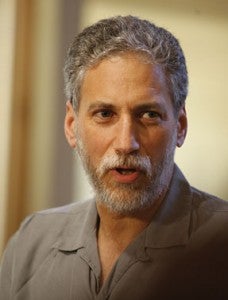Kaid Benfield, Director, Sustainable Communities, Washington, DC
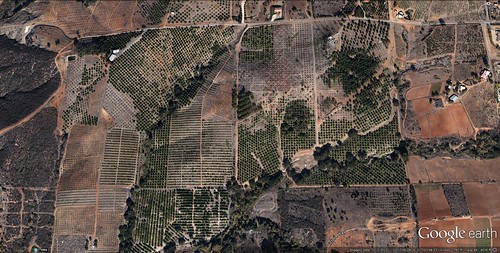
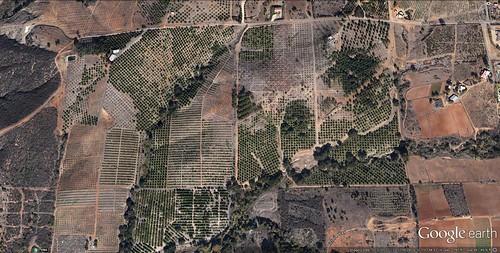
Does the lead photo with this article look like a good place to put over 1700 new homes on a little over 600 acres? What if I told you it was working agricultural land in a remote location 45 miles north of San Diego and 61 miles south of San Bernardino, California? What if I added that the developer is doing everything it can to make the project green? Those are the questions currently facing San Diego County authorities.
The environmental importance of development location
Unfortunately for the proposed project’s sponsor, the most significant factor in determining the environmental impacts of real estate development is the project’s location. Even the greenest development in the wrong location will create more environmental problems than it will solve. Of course, that doesn’t stop developers’ and architects’ green puffery. Heck, they may even be well-intentioned, trying to do the greenest internal design on a site whose non-green location cannot be overcome. But trying to green a project doesn’t make wishes come true.
I’ve written about this sort of thing multiple times, criticizing a purported “net zero” energy-efficient development in Illinoisthat is totally automobile-dependent, and pointing out that higher density, though generally an asset to green performance, won’t cure locational problems. I’ve criticized the American Institute of Architects and even the US Green Building Council for undervaluing location in their green awards programs. (At least USGBC has taken a major positive step by adopting LEED for Neighborhood Development, a certification program that rewards good locations along with other green features. More about LEED-ND later in this article.)
Development locations far from existing cities and towns cause substantial environmental problems, disrupting agricultural lands and natural ecosystems; requiring the spread of resource-consuming infrastructure, including new road capacity that brings more runoff-causing pavement to watersheds; attracting ancillary sprawling development nearby; and causing major transportation impacts.
I can’t over-stress that last point: On average, we use more energy and emit more carbon getting to and from a building than does the building itself. Peer-reviewed research published by the federal EPA shows that even green homes in conventional suburban locations use more energy and emit more carbon that non-green homes in transit-served city neighborhoods. The problem only gets worse when the development is located beyond suburbia on truly rural land. Indeed, the most exhaustive research I know on how land use affects travel behavior found that location – measured by, among other things, the distance from the regional center – is by far the most significant determinant of how much household driving will occur, over time, from a given location.
Simply put, green sprawl is still sprawl.
“An I-15 sustainable community”
This brings me to a proposed “I-15 sustainable community” (the developer’s tagline) on the northern edge some 45 miles north of San Diego County, and 61 miles south of San Bernardino, California. I’m tempted to say that the site is in the middle of nowhere, but that’s not quite fair. It is more accurate to say that it is decidedly rural, home to working orchards, cropland and ranchland on rolling terrain near Lancaster, Pala, and Weaver Mountains. Mountains near the north edge of San Diego County. There are scattered rural residential enclaves and a few small, newer suburban developments within a few miles.
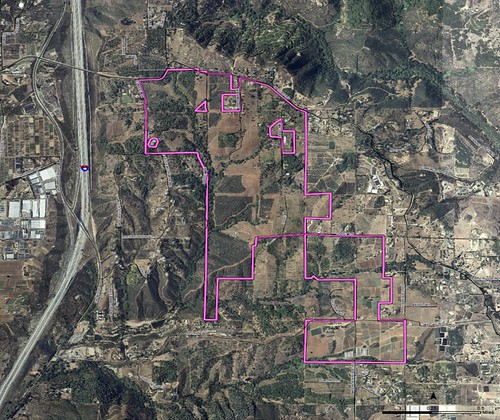
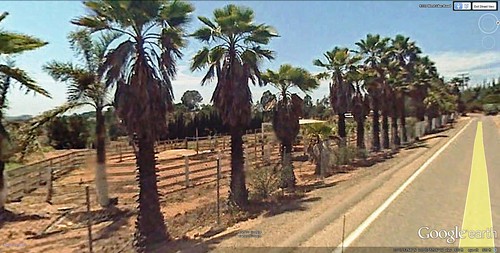
The proposal’s draft environmental impact report describes the setting this way:
“The project site is generally characterized by agricultural lands and gently rolling knolls, with steeper hillsides and ridges running north and south along the western edge. Existing land uses in the surrounding area include residential dwellings that range from suburban to semi-rural densities, along with agricultural uses and vacant lands.”
What the site is not is a good place to put 1,746 new homes at an average density of 2.9 units per acre.
Perhaps that is why it is illegal under current law, which zones the land for agricultural use. That is also its designation in the county’s general plan, recently adopted after more than a decade of deliberation. The developer is seeking to change the zoning and to change the plan to accommodate the development.
The developer’s argument for the proposal, to be called Lilac Hills Ranch, is that it will be internally walkable, with amenities within a 10-minute reach of most residents; that it will cluster development so as to maintain green space; that it will utilize green technology in building design; and that it will create “a neighborhood grounded in traditional small-town values embracing 21st Century design and sustainability.”
To be honest, that sounds pretty nice if it were located adjacent to existing development instead of leapfrogging across vacant land. But it isn’t; I took a look at some numbers. Because the site is unusually shaped and mostly open land, it is hard to find a point within it that is catalogued in searchable databases. So I picked a spot on the north edge of the site on West Valley Road, the main access to the site from I-15, and ran it through some calculators.
Location by the numbers
Google Maps says the north side of the project is 14 miles from San Marcos, the nearest town with significant employment, 16 miles from downtown Escondido, and 22 miles from Rancho Bernardo. As noted, it is 45 miles from downtown San Diego. We’re talking about very long work commutes. There is no transit nearby and, even under the best of circumstances, unlikely to be any future transit that would go conveniently from the development to San Diego County’s scattered work sites.
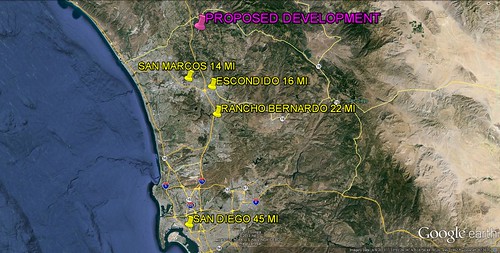
My spot’s Walk Score was 2. Pretty low, eh? Walk Score basically measures how close a site is to shops and conveniences. Ideally, it finds walkable locations with ratings above 60 or so that have things within walking distance. The average Walk Score Sore for Escondido is 51. For San Diego city, the average Walk Score is 56. The average in Los Angeles is 66. A Walk Score of 2 means that this site is not near much, to say the least.
I also ran it through the Abogo calculator maintained by the Center for Neighborhood Technology, which displays driving rates and costs, along with emissions data, for given locations. The average household in the general vicinity of the proposed development emits 1.02 metric tons of carbon dioxide each month just from transportation. This is 46 percent above that of the San Diego region as a whole.
The developer apparently wishes believes that Lilac Hills Ranch would actually reduce greenhouse gas emissions by up to 40 percent compared to a “business-as-usual” scenario, mostly because of the project’s internal walkability and planned commercial spaces that would absorb trips that otherwise would be made outside the project. Nothing in the literature of transportation research suggests that would be the case.
First, let’s parse what “business as usual” means. What the developer is really claiming is that the project would reduce emissions compared to an even more sprawling development in the same location. The developer is not claiming, nor could it, that the project would reduce emissions below the average for the metropolitan region or even below the amount that would be experienced in an alternative site closer to Escondido or San Diego. As noted above, the most exhaustive research on the subject (Professors Ewing and Cervero’s epic “Travel and the Built Environment,” published in the Journal of the American Planning Association) found that proximity to downtown and other major destinations, not internal design, was the most significant factor in determining driving rates. (“Almost any development in a central location is likely to generate less automobile travel than the best-designed, compact, mixed-use development in a remote location,” write the scholars.)
Look, this proposal basically would replace working agricultural land with a commuter suburb, albeit with some very nice internal amenities for its residents.
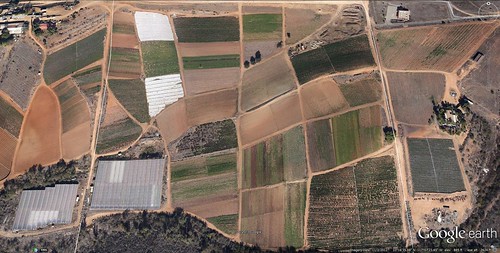
Dan Silver, MD, executive director of the Endangered Habitats League, summed the League’s position in a letter to the San Diego County planning office, which is apparently reviewing the proposal:
“This project would create a commuter-based ‘bedroom’ community in an agricultural portion of Valley Center. It would shred the consensus reached for the Valley Center community as part of the historic General Plan Update, just adopted in 2011. No compelling planning rationale or deficit in housing capacity is present to justify this proposed amendment.”
The League is not alone in its criticisms. The Valley Center Planning Group voted 11-1 to send a scathing critique of the proposal to the planning office, according to an article by David Ross published last month on the local news site Valley Road Runner. If anything, the Planning Group’s language was even stronger than that of the Endangered Habitats League, reports Ross:
“Key take-aways from the response the Planning Group approved Monday night:
• “The project is leapfrogging leapfroging and therefore contrary to the good planning principles upon which the General Plan Update was based. It plops urban building densities into a rural agricultural area without appropriate existing infrastructure.A much better project alternative than any proposed is within the Downtown Escondido Specific Plan Area, says the review.
• “In most major areas of the project, the rationale presented by the applicant is going to change the General Plan requirements to be aligned with what it wants to do. According to the group, this defeats the efforts by all who participated in the 12-year-long, $18 million county General Plan Update project that was approved by the Board of Supervisors only two years ago.”
It seems to me that the planning office should be encouraging green revitalization and redevelopment within cities and towns, and encouraging the addition of new green features to existing suburbs. In some cases, it might be reasonable to review even a new mega-project such as this one if it were not only green but also adjacent and connected to existing development. But, assuming the worst, what’s the point of having a planning office if it approves leapfrog development that violates its own plan?
The project, LEED-ND, and California planning law
Adding rhetorical insult to environmental injury, a document prepared in support of the development asserts that the proposal is “designed to meet the environmental standards of” LEED for Neighborhood Development, the voluntary green rating system mentioned at the top of this article. (See our Citizen’s Guide.) Seriously? Then file an application and get a certification that proves it. Heck, you could at least apply to the US Green Building Council, which administers LEED-ND, for a “prerequisite review” that for a fraction of the cost and time of full certification will determine whether you meet the rock-bottom minimum locational standards of the system.
Given the serious doubts raised about this proposal, if I were a planning official for San Diego County I would politely ask that the developer do just that as a condition of further discussion of any zoning change or planning amendment. Speaking for myself, my informal opinion based on about a dozen painful hours of reviewing planning documents in this case is that there is not a snowball’s chance in hell that this proposal qualifies for LEED-ND certification or even that it would pass the minimum prerequisites to be considered.
For one thing, LEED-ND requires a minimum average density of seven dwellings per acre, not the 2.9 at issue here. For another, the LEED-ND locational prerequisite is generous, but not generous enough to let this project slip through. (I should know, because I was its principal author.) To be considered, a project must qualify as (1) infill; (2) adjacent and connected to a minimum amount of previous development; (3) served by existing or fully committed minimum transit service; or (4) surrounded by a minimum number of specified, pre-existing “neighborhood assets” within walking distance. In other words, a project can’t be smack in the middle of rural land at a long distance from existing development. Well, it can be, but it won’t – and shouldn’t – qualify for green certification under LEED-ND.
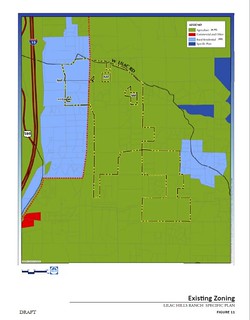

Current agricultural zoning (left) and proposed change to "residential urban" (right)
Finally, in 2008 California passed what many of us believed at the time to be landmark legislation (“SB 375”) requiring that each metropolitan area in the state, including San Diego County, develop specific, long-range land use and transportation planning documents that meet assigned targets for reducing emissions of greenhouse gases from transportation. A lot of people in the state, including my NRDC colleague Amanda Eaken, worked long and hard to ensure that the new law would be fair to developers and municipalities as well as protective of the environment. They succeeded at that, and won the support of a broad range of nonprofit and commercial interests.
Basically, each metro area must develop a “Sustainable Communities Strategy” as part of its transportation plan. The SCS must anticipate population growth and housing needs and allocate them to areas within the region that can accept them consistent with the law’s environmental aims. The state’s Air Resources Board must review and certify that the plans are adequate to meet their emissions-reduction targets. Municipalities are expected to conform to the regional plans, and transportation funding and development approval benefits flow to the priority growth areas.
The whole point of SB375 was to encourage development within or close to existing development and existing city and town infrastructure. (And, no, contrary to the developer's assertions here, being close to an Interstate highway is not what the framers had in mind when they spoke of existing city and town infrastructure.)
The Sustainable Communities Strategy for San Diego County, crafted by the San Diego Association of Governments and adopted two years ago, was built on the premise that the county’s general land use plan would remain in place. As a result, this development not only challenges the plan; it also flies in the face of all the hard work and good faith that went into the region’s Sustainable Communities Strategy pursuant to SB375. This should matter, not just a little but a lot. As far as I could tell from the documents I reviewed, the SCS isn’t even mentioned.
The bottom line: in another place, this might be a great green development, though I would want to improve its design for better walkable density and transit access. Its on-site premises do appear to have some merit to them. But this location is so, so wrong that it negates what might otherwise be the development's environmental assets. It's a shame because, in the end, the development basically amounts to little more than pretty sprawl.
Related posts:
- Suburban sprawl could destroy up to 34 million acres of forests, says new study (January 8, 2013)
- How California is planning growth for a prosperous economy and clean environment (September 25, 2012)
- It doesn't have to be low-density to be sprawl (August 6, 2012)
- Knowing when it's green: A Citizen's Guide to (LEED for) Neighborhood Development (May 25, 2011)
- California air board sets enforceable targets for smart planning (September 28, 2010)
- What does 'net zero' mean? Sprawl by another name? (August 19, 2010)
- New California report shows well-planned land use could dramatically reduce pollution, household costs (June 24, 2010)
- ULI gives strong endorsement to California smart growth law (June 10, 2010)
- LEED for Neighborhood Development formally launches to promote smart, sustainable land use (April 29, 2010)
Move your cursor over the images for credit information.
Kaid Benfield writes about community, development, and the environment on Switchboard and in other national media. For more posts, see his blog's home page. Please also visit NRDC’s Sustainable Communities Video Channels.

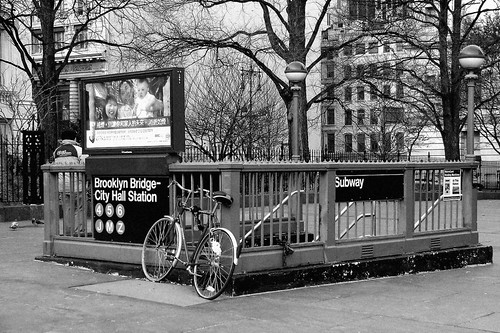 tating towards more vibrant and compact communities that facilitate car-free lifestyles. In doing so, millennials are helping push American transportation preferences in a new direction.
tating towards more vibrant and compact communities that facilitate car-free lifestyles. In doing so, millennials are helping push American transportation preferences in a new direction.








